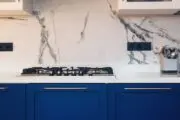Design elements that support aging in place offer flexibility for homeowners to safely stay in their homes for as long as they want, on their own terms. These design elements also contribute to the overall aesthetic, with predominantly open-concept floor plans, pleasing color palettes and loads of natural light.
Benefits of new construction homes for aging in place
While homeowners can retrofit or add on to an existing home to make it suitable for aging in place, it is easier, more convenient and often more cost-effective to include design elements and infrastructure during the construction phase of a new build.
New construction homes typically have the latest tech as well, which elevates functionality and also ticks off an important box for aging in place, including high-tech, low-maintenance, energy-efficient appliances.
What design elements are recommended for aging in place?
A lot of design features that support aging in place also contribute to the overall style and décor of a new home, such as oversize doorways, wide hallways and large windows that let natural light flow freely. And the coveted open-concept floor plan is a must for aging in place because of wide sightlines and low barrier to movement.
Some other must-have aging in place design features include:
- Easily accessible storage, ideally with built-ins.
- Have at least one entrance to the home be accessible (i.e., no stairs).
- Employ smart tech, particularly when it comes to appliances and for safety features, such as smoke, water and gas leaks.
- Low maintenance exteriors and landscaping.
- For futureproofing, ensure that there is abundant connection and fiber for wi-fi and infrastructure for electrical, as homeowners may want to automate/smart enable several household products and services down the road.
- In the bathroom, curbless, oversize shower and lever-activated faucets.
- In the kitchen, varied counter heights, with workstations that permit sitting or standing. Open shelving, or pull-down/pull-out features in base cabinetry for easy access to high-touch items.
- In the laundry, front-load machines and low cabinetry.
- Easy to care for flooring, with minimal transitions among materials.
These are only a selection from dozens of recommendations with aging-in-place design, which underscores the value of working with a builder or designer that is trained specifically to support these design objectives.
What floor plan is best?
“A floorplan that fits buyers’ current and future needs without sacrificing quality is crucial when downsizing,” Michele Pasquantino, market manager at Drees Homes.
“Homebuyers should look for one-level, open floorplans with accessible features that allow for aging in place comfortably,” says Pasquantino.
Ideally, a one-level home, such as the popular ranch style, is easiest in terms of accessibility, but it is possible to have a two-story home that could support aging in place.
If a homeowner wants a two-story home, make sure that there is a main-floor bathroom with a shower (or a bathroom that could easily be converted to have a shower). Similarly, having a main-floor den or flex room that could be converted to a bedroom if needed is smart too.
It’s also advisable to plan for an elevator, which could mean stacking storage areas (i.e., closets) one on top of each other, so that the passage could easily be converted to an elevator shaft when stairs become an issue.
The right flooring
One of the greatest hazards in a household, particularly for homeowners as they age, is flooring. From piling rugs to thick carpet or transition strips where flooring type changes, tripping and falling is a clear and present danger.
The solution is to have uniform flooring throughout that is easy to maintain, such as ceramic tile or vinyl plank, which is particularly popular as much for its aesthetics as it is for its durability and relative forgiveness in the event of a fall.
“When it comes to comes to aging in place you want the surface to have some flexibility. For equipment, you want something that won’t hinder mobility,” says Lori Bellport, founder of Live in Place Designs
If a homeowner has their heart set on carpet, Bellport recommends “low-profile, almost commercial grade or Berber- type carpet.”
Lighting plays an important role
Eyesight diminishes as we age, which means that having proper lighting is essential for safety.
Seniors require “70 precent more light than someone in their 20s,” to see properly, says Lisa Cini, president and CEO of Mosaic Design Studio.
To compensate, leverage every opportunity for natural light (think many windows, skylights etc.) and ensure that lighting is strategically placed throughout the home.
“You must start with enough natural light in the design and then introduce artificial light to make sure that the space is well lit overall,” says Bellport.
This should include a combination of overhead and accent lighting, as well as task lighting such as pot lights or undercabinet lighting.
Don’t forget lighting in traditionally dimly lit locations, such as hallways and closets.
It’s also a good idea to have lights on sensors, eliminating the need to fumble with switches and to take extra steps to turn them on and off.
Remember to make sure the home’s exterior is well lit, particularly at doorways, for safety and security.
Color choices
Materials, colors and décor choices can enhance comfort and usability, sensitive to changing perceptions of the space around us as we age. Creating contrast can draw desired areas into focus.
Cini recommends creating contrast with color and applying the technique in a few key areas, such as making the floor wall base / bottom of a wall, a contrasting color from the floor. “This helps to see where the wall and floor meet,” she says.
“At the bottom and on the top landing of a staircase should be a different or contrasting color to the surrounding floor and or stair color,” says Cini, again to help with depth perception and to signal transitions.
Other areas to use contrast in colors are on handrails and grab bars, contrasting tile behind a toilet (makes it easier to see at night) and even contrasting color on furniture to help delineate seating.
Also, embracing the hot biophilic trend of incorporating natural colors and materials inside is helpful, because of the calming connection that nature provides.
“Incorporate biophilic design as much as possible. Bring the outdoors in and use colors that are really supportive of well-being and healing, with natural light, paint colors, tile etc.” says Bellport.
Picking the right community
The real estate mantra of ‘location, location, location’ is particularly relevant for homeowners who are looking to age in place. Proximity to amenities, such as shopping, recreation and healthcare is important.
That’s in part why retirement communities are so popular with homeowners planning to age in place, especially for those who seek on-site amenities
“Yoga rooms, bocce ball, pickleball courts and large fire pits that allow for conversation and connection are among some of the amenities popular in 55+ communities,” says Pasquantino.









